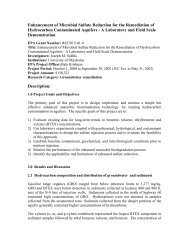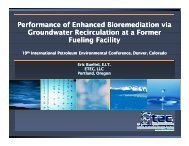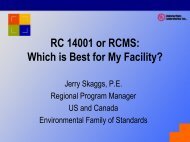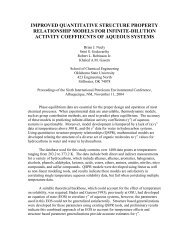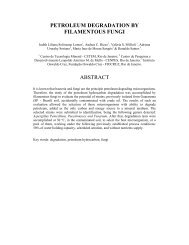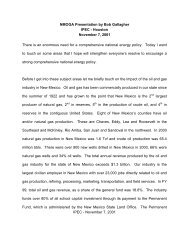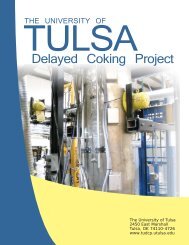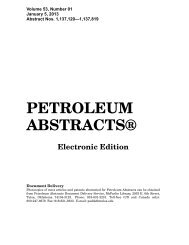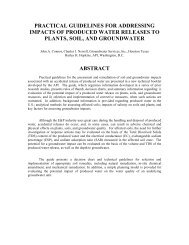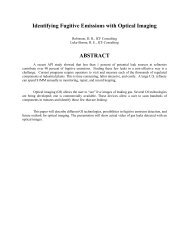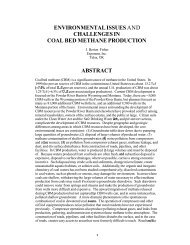How to Hack Your Mini Cooper: Reverse Engineering CAN ... - Defcon
How to Hack Your Mini Cooper: Reverse Engineering CAN ... - Defcon
How to Hack Your Mini Cooper: Reverse Engineering CAN ... - Defcon
You also want an ePaper? Increase the reach of your titles
YUMPU automatically turns print PDFs into web optimized ePapers that Google loves.
<strong>How</strong> <strong>to</strong> <strong>Hack</strong> <strong>Your</strong> <strong>Mini</strong> <strong>Cooper</strong>:<br />
<strong>Reverse</strong> <strong>Engineering</strong> <strong>CAN</strong> Messages<br />
on Passenger Au<strong>to</strong>mobiles<br />
Jason Staggs<br />
Computer Science / www.isec.utulsa.edu
Who is this guy?<br />
• Jason Staggs<br />
– Graduate Research Assistant<br />
• Institute for Information Security (iSec)<br />
• Crash Reconstruction Research Consortium (TU-CRRC)<br />
– TRUE Digital Security<br />
• Cyber Security Analyst<br />
Computer Science / www.isec.utulsa.edu
Why do we hack cars?<br />
• Related work<br />
– “Experimental Security Analysis of a Modern Au<strong>to</strong>mobile”<br />
– “Comprehensive Experimental Analyses of Au<strong>to</strong>motive Attack<br />
Surfaces”<br />
• Understanding computer and network systems on cars<br />
– Underlying <strong>CAN</strong> pro<strong>to</strong>col and components lack of<br />
authentication and verification of messages<br />
• Understanding potential points of vulnerability<br />
– Vehicle network security is in its infancy<br />
• But most importantly…<br />
Computer Science / www.isec.utulsa.edu
To prevent this…<br />
Computer Science / www.isec.utulsa.edu
From turning in<strong>to</strong> this…<br />
Computer Science / www.isec.utulsa.edu
Because of this...<br />
Computer Science / www.isec.utulsa.edu
<strong>CAN</strong> Clock Project<br />
• Research project developed as a proof of concept<br />
– Manipulating <strong>CAN</strong> nodes via <strong>CAN</strong> network<br />
– <strong>Reverse</strong> engineering <strong>CAN</strong> messages<br />
– 2003 <strong>Mini</strong> <strong>Cooper</strong><br />
Computer Science / www.isec.utulsa.edu
Vehicle communication networks<br />
• Common vehicle pro<strong>to</strong>cols<br />
– <strong>CAN</strong> (Most widely used among manufactures)<br />
– FlexRay<br />
– LIN<br />
– MOST<br />
– J1850 (GM/Chrysler)<br />
– J1939 (Heavy Trucks)<br />
– J1708/J1587 (Being phased out due <strong>to</strong> J1939)<br />
• 2008: All US cars use <strong>CAN</strong> for mandated EPA diag.<br />
Computer Science / www.isec.utulsa.edu
Interconnected vehicle networks<br />
Computer Science / www.isec.utulsa.edu
Controller Area Networks<br />
• Bosch <strong>CAN</strong> standard<br />
– Developed in the 80s<br />
– European au<strong>to</strong>motive manufactures were early adopters<br />
– Multi-master broadcast message system<br />
– Standard Format<br />
• 11-bit message ID<br />
• 2^11 or 2048 possible message IDs<br />
• MFG. use of proprietary IDs for their ECUs<br />
– Extended Format<br />
• 29-bit message ID<br />
• 2^29 or 537 million message IDs<br />
• Used extensively by J1939<br />
Computer Science / www.isec.utulsa.edu
<strong>CAN</strong> Frame<br />
– SOF – Start of Frame<br />
– Identifier – Unique identifier for message along with priority<br />
– RTR – Remote Transmission Request<br />
– IDE – Identifier extension (distinguishes between <strong>CAN</strong> standard and<br />
<strong>CAN</strong> extended)<br />
– DLC – Data Length Code (frames have up <strong>to</strong> 8 bytes of data)<br />
– CRC – Cyclic Redundant Check sum<br />
– ACK – Acknowledge<br />
– EOF – End of Frame<br />
– IFS – Intermission Frame Space<br />
Computer Science / www.isec.utulsa.edu
Electronic Control Units (ECUs)<br />
• ECUs designed <strong>to</strong> control:<br />
– Vehicle safety systems<br />
• Engine control unit<br />
• ABS braking system<br />
• Door locks<br />
– Non safety critical systems<br />
• Radio deck<br />
• HVAC system<br />
– The list goes on…<br />
• Programmable ECUs<br />
– Allows MFGs <strong>to</strong> update firmware on ECUs<br />
• Average modern day car has ~70 ECUs<br />
Computer Science / www.isec.utulsa.edu
<strong>Reverse</strong> <strong>Engineering</strong> <strong>CAN</strong> Messages<br />
• What we want <strong>to</strong> do:<br />
– Manipulate <strong>CAN</strong> enabled vehicle components (Instrument Cluster)<br />
• Problem:<br />
– Manufactures do not publish <strong>CAN</strong> message information about<br />
specific <strong>CAN</strong> components (ECUs)<br />
• Solution:<br />
• Message IDs<br />
• Payload information (Byte offsets)<br />
– A method for visually correlating physical system interactions<br />
with identifiable patterns. (Humans are good at this)<br />
– Fuzzing (DANGER WILL ROBINSON!!!)<br />
Computer Science / www.isec.utulsa.edu
<strong>Reverse</strong> <strong>Engineering</strong> <strong>CAN</strong> Messages<br />
• Passively captured <strong>CAN</strong> traffic during a staged test run<br />
– In this case it was a staged au<strong>to</strong>motive collision.. <br />
– <strong>Mini</strong> <strong>Cooper</strong> vs. GMC Envoy (Check out TU-CRRC website for<br />
killer crash videos)<br />
– Data capture lasted for roughly 90 seconds<br />
• Data Log gives us ~106,000 data entries of <strong>CAN</strong><br />
messages<br />
Computer Science / www.isec.utulsa.edu
Computer Science / www.isec.utulsa.edu
<strong>CAN</strong> Data Log<br />
• Contained ~106,000 data entries<br />
• Bash “cut –d. –f3 cooperheadion.txt | sort | uniq –c”<br />
– Only 15 Unique <strong>CAN</strong> IDs!?<br />
Message Frequency<br />
<strong>CAN</strong> IDs<br />
12706 153<br />
12706 1F0<br />
12706 1F3<br />
9460 1F5<br />
12707 1F8<br />
8899 316<br />
8899 329<br />
Computer Science / www.isec.utulsa.edu
Visually Identifying <strong>CAN</strong> Messages of Interest<br />
Message ID 0x153 Vehicle Speed<br />
Computer Science / www.isec.utulsa.edu
Vehicle Speed (MPH)<br />
`<br />
0x153 Byte 2 <strong>CAN</strong> Message<br />
30<br />
25<br />
20<br />
15<br />
10<br />
5<br />
0<br />
0 10 20 30 40 50 60 70 80 90 100<br />
Time (sec)<br />
Computer Science / www.isec.utulsa.edu
<strong>Reverse</strong> <strong>Engineering</strong> <strong>CAN</strong> Messages<br />
• Speedometer and Tachometer Message IDs<br />
– 2 methods<br />
• For each message ID, plot data values vs. timestamp in order <strong>to</strong><br />
determine physical significance.<br />
• Given possible <strong>CAN</strong> IDs, fuzz data fields until needles start moving<br />
<strong>CAN</strong> Message ID Description<br />
0x153 Byte 2<br />
0x316 Byte 3<br />
0x329<br />
0x61A<br />
0x61F<br />
Speedometer (Vehicle Speed)<br />
Tachometer (Engine Speed)<br />
Various indica<strong>to</strong>r lights<br />
Controls the messages being displayed on the tachometer<br />
LED screen<br />
Tachometer along with various indica<strong>to</strong>r lights<br />
Computer Science / www.isec.utulsa.edu
Building the <strong>CAN</strong> Clock and Network<br />
• <strong>CAN</strong> Bus<br />
– 18 gauge wire<br />
– 2 x 120 ohms terminating resis<strong>to</strong>rs<br />
– 12V DC power source<br />
– Arduino Uno microcontroller<br />
– <strong>CAN</strong> Bus Shield<br />
• MCP2515 <strong>CAN</strong> controller<br />
• MCP2551 <strong>CAN</strong> transceiver<br />
– <strong>Mini</strong> <strong>Cooper</strong> Instrument Cluster<br />
– Real time clock module RTC (for clock mode)<br />
Computer Science / www.isec.utulsa.edu
Computer Science / www.isec.utulsa.edu
<strong>CAN</strong> Clock Proof of Concept<br />
• Talking <strong>CAN</strong> with Arduino<br />
– Arduino and <strong>CAN</strong> Controller Libraries<br />
• MCP2515 (Communication with <strong>CAN</strong> transceiver)<br />
• SPI (Used for communications between Arduino and <strong>CAN</strong> shield)<br />
• 2 Modes of operation<br />
– Clock Mode<br />
– Demo Mode<br />
Computer Science / www.isec.utulsa.edu
Demo<br />
Computer Science / www.isec.utulsa.edu
Gaining Physical Access <strong>to</strong> <strong>CAN</strong> Bus<br />
• Via OBD2<br />
• Tapping the <strong>CAN</strong> bus (vampire tap)<br />
– Under the hood<br />
– Breaking a powered side view mirror<br />
– Etc.<br />
• 0 <strong>to</strong> pwned for less then $100<br />
– Rogue Arduino <strong>CAN</strong> node<br />
• Potential conspira<strong>to</strong>rs<br />
– Mechanics<br />
– Car Rentals<br />
– Coworkers/Family/Friends/Valets/Ex-girlfriends/etc.<br />
Computer Science / www.isec.utulsa.edu
Conclusion / Future Work<br />
• Better access control between vehicle network<br />
components<br />
– ECU <strong>to</strong> ECU<br />
– OBD2 <strong>to</strong> ECU<br />
• Applying conventional NIPS & firewall methods <strong>to</strong> <strong>CAN</strong><br />
– Message anomaly prevention depending on context?<br />
Computer Science / www.isec.utulsa.edu
For more Information<br />
• TU Research<br />
– http://isec.utulsa.edu/<br />
– http://tucrrc.utulsa.edu/ ← Check out our research and crash tests <br />
– http://tucrrc.utulsa.edu/canclock/<br />
• <strong>CAN</strong> Standards/Docs<br />
– http://esd.cs.ucr.edu/webres/can20.pdf (<strong>CAN</strong> 2.0 Spec)<br />
– http://www.sae.org/standards/<br />
Computer Science / www.isec.utulsa.edu
Questions??<br />
• jason-staggs@utulsa.edu<br />
Computer Science / www.isec.utulsa.edu



